How to Use the True Strength Index (TSI) in Forex Trading
The True Strength Index (TSI) is a technical indicator used in forex trading to identify overbought and oversold conditions, as well as to spot potential trend reversals. Here are some steps to help you effectively use the TSI in your forex trading strategy:
- Understand the TSI Formula: The TSI is calculated using two smoothed moving averages of price momentum, resulting in a line that oscillates around a centerline. Positive values indicate bullish momentum, while negative values indicate bearish momentum.
- Set Up Your Trading Platform: Most trading platforms have the TSI indicator readily available. Add it to your forex chart to start analyzing price movements.
- Identify Overbought and Oversold Conditions: The TSI can help you identify overbought and oversold market conditions. Generally, if the TSI crosses above the overbought level (typically at +25) or below the oversold level (typically at -25 or -50), it suggests a potential reversal in price. However, you can adjust these levels based on the currency pair and timeframe you are trading.
- Look for Divergence: Divergence occurs when the TSI moves in the opposite direction of price. For example, if price makes higher highs while the TSI makes lower highs, it indicates a potential weakening of the prevailing trend. This can serve as a signal for a possible trend reversal.
- Confirm with Other Indicators: The TSI works best in conjunction with other technical indicators to increase the accuracy of your trading signals. Consider combining it with other tools such as moving averages, support/resistance levels, or Fibonacci retracements to confirm potential entry or exit points.
- Practice Risk Management: Like any indicator, the TSI is not foolproof. It is essential to use proper risk management techniques, including setting stop-loss orders and defining your risk tolerance, to protect your trading capital.
- Backtest and Refine: Before implementing the TSI into your live trading strategy, backtest it using historical data and assess its performance. Adjust the parameters or combine it with other indicators to optimize its effectiveness for your preferred trading style.
Remember, the TSI is just one component of a comprehensive trading strategy. It is crucial to consider market conditions, fundamental analysis, and other factors that impact the forex market. Use the TSI as a tool to guide your decisions, but always supplement your analysis with a well-rounded approach to forex trading.














Post Comment